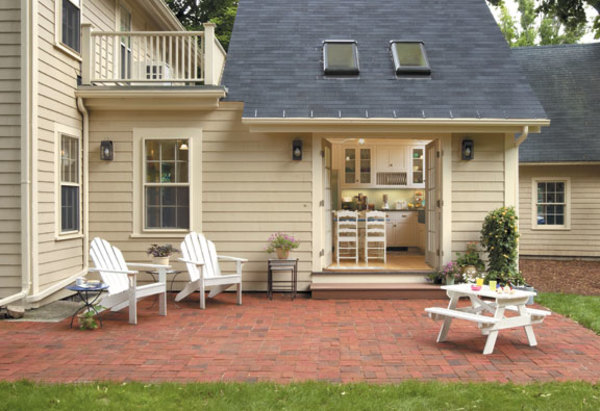
The addition to this Massachusetts farmhouse is a basic ell off the back of the house, which echoes the home’s original form through roof pitch and window sizes.
We’ve all seen one: the old house that suddenly sprouts an obtuse room extension or overpowering wing addition, subverting the stylistic form and swallowing its original structure —all in the pursuit of increased space. Additions to old houses don’t have to be incongruous appendages out of sync with the scale and details that give the building its character. Studying your house’s historic plan, shapes, and materials—the architectural “genetics” that already exist—then applying some common-sense design principles and time-tested ideas can help it grow in a way that fits both the building and your lifestyle needs. Here are five basic ideas to remember when considering additions to old houses and how they were used to successfully complete five widely varying projects.
Keep the addition in the background
“When we wanted to add on to our house,” says Andrea Wald of Framingham, Massachusetts, “we looked at the only practical option: the back of the building.” Andrea and her husband, Mark, didn’t want the addition to disrupt the symmetry of the New England farmhouse or be visible from the road. On top of this the original rear façade was a nearly perfect blank slate to build their addition.
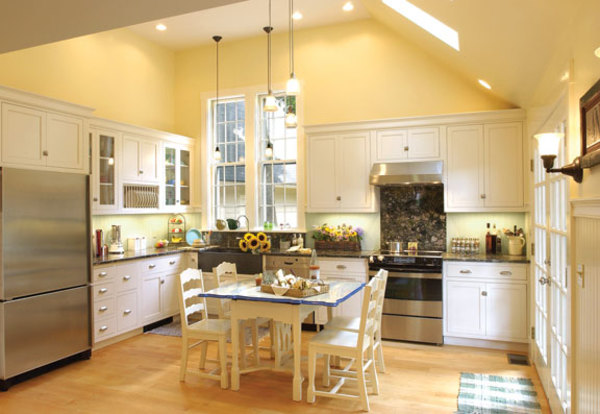
Homeowner Andrea Wald and architect Jonathan Hale created a modern, functional kitchen while maintaining a sense of the home’s past. Andrea chose simple cabinetry, beadboard wainscotting, and 5”-wide maple floorboards to maintain an old-house feel.
Damianos Photography
“Placement is a key consideration when planning an addition,” says architect Jonathan Hale, who designed the kitchen, mudroom, laundry, and bath addition for the Walds. Adding onto the back preserves the public façade of the house, thereby maintaining the historic character of the home and the context of the neighborhood. Moreover, building onto the rear is the most common growth pattern for a house in New England, as well as across the country. From late 16th-century Capes to vernacular farmhouses of the 19th century, ell extensions—typically for a “modern” stove-equipped kitchen—were regularly added off the back, and on New England farms that room might also grow a winter passage to the barn. The local historic precedent for such an addition helps it look correct in a new project. “To work, the addition needs a sense of belonging,” says Hale. “Each individual house has a personality, so I ask, ‘What is the house telling me? What are the rhythms of the house?’”
Architect Chris Jenkins also believes in creating a vernacular narrative for a new addition. He looks at the history of similar houses in an area to discern how the house he is adding onto might have grown in the past. In the case of the garage addition beside an 1828 Virginia farmhouse, Jenkins gave the exterior of the addition the look of 19th-century summer kitchens attached to houses throughout the region. Jenkins is no less mindful of contemporary practices and he also looks at any existing property constraints. He recommends that you ask, “Is this a historic district? What are the set-back ordinances? Do I need to get a variance?”
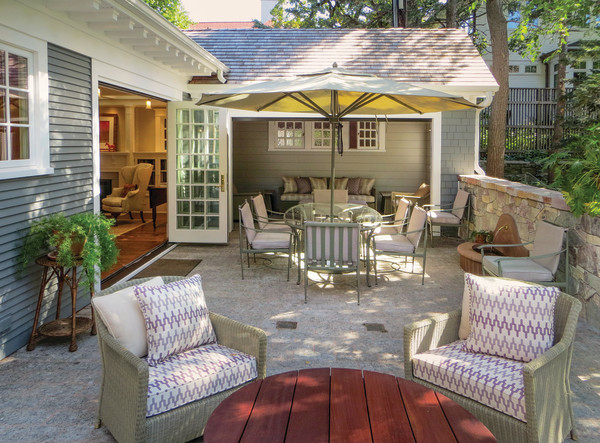
The new terrace just off the family-room addition extends living and entertaining space, and offers views to a lake. The terrace flooring is natural Ubatuba granite
Susan Gilmore
Study proportions
Whether it is the length and width of a porch, or the dimensions and placement of windows, when code allows do your best to maintain and emulate the original proportions of an old house in an addition. While the specific materials will be new and possibly different in their details, respecting original proportions will help avoid upsetting the overall historic character of the building—for example, the horizontal emphasis of Prairie-influenced houses—as well as bridge past and present.
“Southern structures were typically one room deep to allow cross breezes that beat the South’s summer climate,” says Jenkins. “They were also built this way as a function of the timber construction; the length of timber determines room size.” An addition that ignores dimensional parameters of the house’s original structural system, or grafts an incompatible structural system, will look out of place and out of time.
When homeowner Pat Durbin wanted to build onto her Victorian-era carriage house-cum-home in Port Townsend, Washington, the original 10´-wide porch dictated the space that could be added to the building. They wrapped the porch around the right side of the house, using that 10´- wide dimension as a guide, without disrupting the house’s original scale. A master bathroom sits above the new porch extension. The Durbins also carried the original window measurements into the new structure.
Size matters; keep scale subordinate
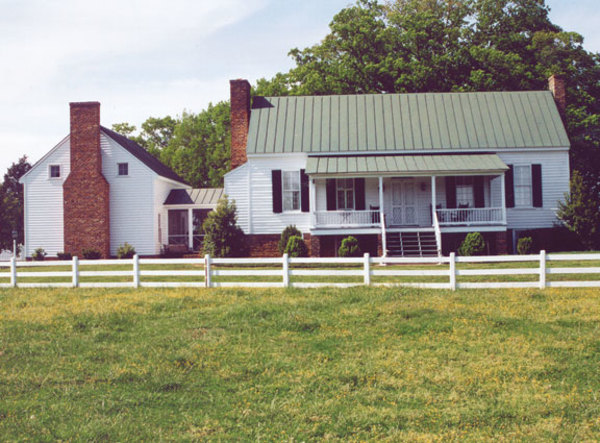
To allow the historic portion of an 1828 Virginia farmhouse to remain visually distinct, the 700-square-foot garage addition was conceived as a detached summer kitchen. The addition was placed perpendicular to the house with a screened-porch connector.
Many unappealing additions suffer from gigantism. When occupants want more space, they often concentrate on gaining more square footage on the interior, but overlook the impact on the exterior. Compared to public buildings, houses are small and consequently tricky to expand easily; small houses are even harder. What’s left of an 1,800-square-foot Foursquare if you try to append a 2,000- square-foot addition?
Most successful additions to old houses keep the size and scale smaller so that they “read” as secondary. “Allow the original structure to take center stage and let the addition be subordinate,” says designer David Heide. For a 1904 Queen Anne in Minneapolis, Minnesota, Heide chose to keep the addition to a single storey at the back.
Keep the dimensions small and spend your money on the details that will create a harmonious transition from the old to new space. This rule will help maintain the overall character of the older structure. Building below the line of the original roof and setting back walls from primary façades are also key in subordinating an addition.
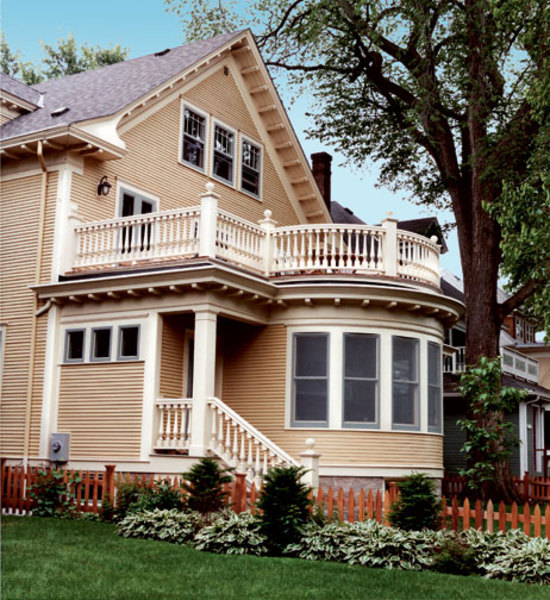
Designer David Heide created an entryway with a semicircular family room—a form not found on this particular building but on other houses in the neighborhood—with an adjacent study. (Photo: David Heide)
Respect original materials and details
A new addition to an old house has the potential to damage its historic materials and features. Before you begin the project, get to know your house. “Study the original structure thoroughly, and then tread lightly,” says Jenkins. Document existing materials and take measurements of the floor plan, vertical heights, and the components of the house—its windows, doors, and cladding. With copious notes in hand, your designer or architect can replicate details from the original house into the new addition.
When designing additions to historic buildings, architects find creative ways to preserve as much of the original structure as possible. In the Wald House in Massachusetts, Hale created a hyphen (connector) between the addition and the original structure. This 6´-tall connector has the same ceiling height of the original house. The larger portion of the addition opens into the kitchen with a cathedral ceiling. In creating this compact access to the addition, Hale kept all the second-floor windows, saving precious natural light. For the Virginia farmhouse addition, Jenkins designed a small breezeway connector leading from the house to the garage. Again this smaller hyphen preserved much of the original wall.
When it comes to the new work, materials and finishes that follow the original details, even when not identical in composition, will echo its character and help the addition look of a piece. Many window companies today are introducing historic proportions in window shapes and muntin patterns. (You can even order windows with traditional pulley- and-chain or rope balances.) Energy-codes permitting, homeowners can opt for single-glazed windows with storms opposed to more modern-looking double-glazed units. Sometimes contemporary materials can be modified to historic dimensions, such as ripping clapboards on site to match originals.
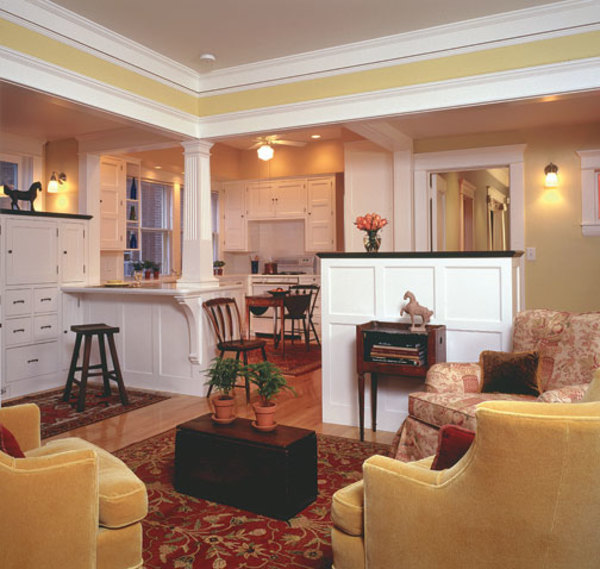
David Heide wanted to create a clear map of what was original and what was not. He delineated one period from another by using different materials from the original. (Photo: Alex Steinberg)
Another good way to maintain continuity between the old and new is to incorporate salvage materials. Jenkins used recycled brick for the new chimney on the Farmville, Virginia, property. He also found a company to match the existing mortar. In his garage addition, Jenkins specified true divided-light 9/9 windows with restoration glass, as well as beaded lap siding and a standing seam roof.
Heide replicated the columns on the front of the Colonial Revival onto the new back porch in a smaller size. Hale added windows in authentic Victorian-era proportions over the sink in the Wald kitchen—a reference to that period. When deciding on interior finishes for an addition, look at the original styling of the house for clues about how that new room should reflect the older structure.
From a historic preservation standpoint, it’s worth noting that there’s a limit to authentic details; in fact, well-done projects make sure to leave enough clues to let the next generation know where the original structure ends and the new one begins. Countless garden-variety old houses have gone through alterations in the past—some seamless, some more obvious. Many architects agree that while it is important to create a felicitous pairing between the old and new, in harmony with the existing building in scale, proportion, materials, and color, the new structure should be identifiable in some way. Often this is achieved through the choice of building materials.
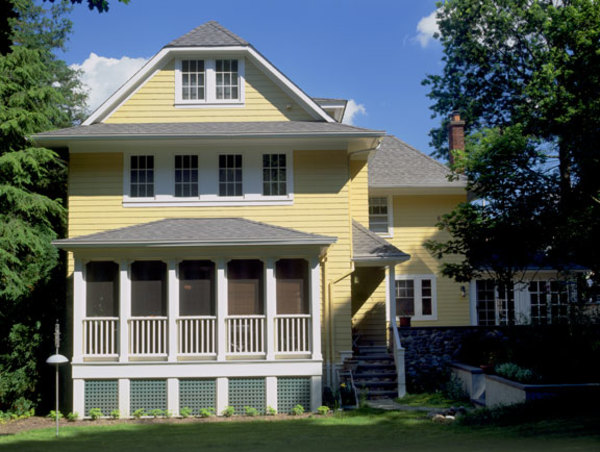
The rear addition was the last of three phases of work on the White residence in suburban New Jersey. A terrace, visible on the right, connects the new entrance with the relocated garage. (Photo: James Prince)
Treat roofs with care
Few features are as character-defining as the roof, and when a roof is compromised by an addition, the addition seldom looks right. Roof form, pitch, and eave/cornice lines are the critical parameters to watch. When the owners of a 1916 Arts & Crafts-influenced house in suburban Madison, New Jersey, began to think about additions, one of the design issues they had to wrestle with was the double-pitch roof.
“The original roof is distinctive,” notes architect Mark Alan Hewitt, “and having it look right when finished was critical.” Before addressing other concerns, Hewitt and his staff concentrated on carefully designing the geometry of the extended roof. Once the roof was worked out successfully, much of the rest of the project, particularly the massing of the rear addition, fell into place underneath it.
The house, purchased in the late 1990s, was not in good condition, plus there was no access from the back of the building. Hewitt addressed the rear access problem first by relocating the garage to the opposite side of the lot, thereby providing access to the rear of the house through the new autoport and terrace. The owners were also determined to retain the existing staircase inside the building while gaining more space for the kitchen and master bedroom.
“Circulation is always an issue,” according to Hewitt, “and one of our challenges was how to keep the staircase without overcomplicating the living room-dining room-kitchen arrangement.” Part of the solution involved adding a windowed gallery in a former solid wall that allowed them to open up the stairway. Adds Hewitt, “My mantra has always been that, with care, it’s possible to design compatible additions without disrespecting the original house.”







